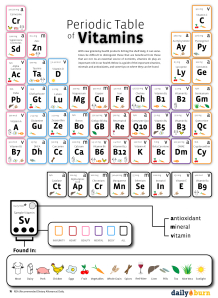The Origin of the Naming of Vitamins
Kamis, 19 Januari 2023
The Origin of the Naming of Vitamins
Maybe you have never thought why the names of vitamins use alphabetical order. It turns out that the name of vitamins with the order of the letters has a long history.
Launching Gizmodo, Tuesday April 1 2014, the naming of vitamins began in the early 19th century. It started with research exploring animal resistance to disease driven by the presence of a substance.
One of the early researchers, Cornelius Adrianus Pekelharing in 1905, argued that milk in animals has several substances that have not been recognized and in very small quantities.
"It is needed for normal growth and maintenance," Pekelharing argues. Later this substance was recognized named and contains vitamins.
Then in 1912, as scientific studies increased, Casimir Funk isolated an organic factor he described as an amine (a kind of amino acid).
Since this element is essential for life, Funk combined the two words to give the term vitamin.
vitamin
Meanwhile, the idea of naming vitamins using alphabetical order can be traced to a thesis by Cornelis Kennedy in 1916. Kennedy was the first to use the names A and B to denote a new food staple. But apparently, Kennedy's mentor, Elmer McCollum is known as the original source for the naming of the vitamin. It was McCollum who was credited with inventing the name vitamin A.
Initially, the naming of vitamins included soluble fats and water. But considering the name of the scientific nomenclature is rather difficult to use, then the food staple is then simplified as vitamins A, B, C and others.
When they were first discovered, namely between 1910 and 1920, vitamins were given the names A, BC, D and E. But interestingly, vitamin D was originally equated with vitamin A, but because the two vitamins
does have two separate factors involved, so finally the two types of vitamins are distinguished.
Then researchers found several vitamins that are of similar elements. For example, in 1920 when several similar B vitamins were discovered, the name was changed to B1 (Thiamin), B2 (Riboflavin). Eventually the remaining B vitamins were lumped together under the designation B complex.
The reason for the unified classification is the loose similarity in properties, their distribution within natural resources, as well as their overlapping physiological functions.
There are many types of B vitamins. But the B vitamins don't always show chronological order, for example B12 (Kobalamin), discovered in 1926, B5 (pantothenic acid), B7 (Biotin) in 1931, B6 (pyridoxine) in 1934, B3 (Niacin), B9 (folic acid) in 1941.
Currently the order of vitamins also jumps, after vitamin E directly to vitamin K. Vitamin F is reclassified as is the case with the naming of some B vitamins. Vitamin F is known as a staple fatty acid (Omega 3 and 6). Vitamins that are also reclassified are Vitamin G which is included in Vitamin B2.
sumbur: http://goo.gl/Wt5vJk


